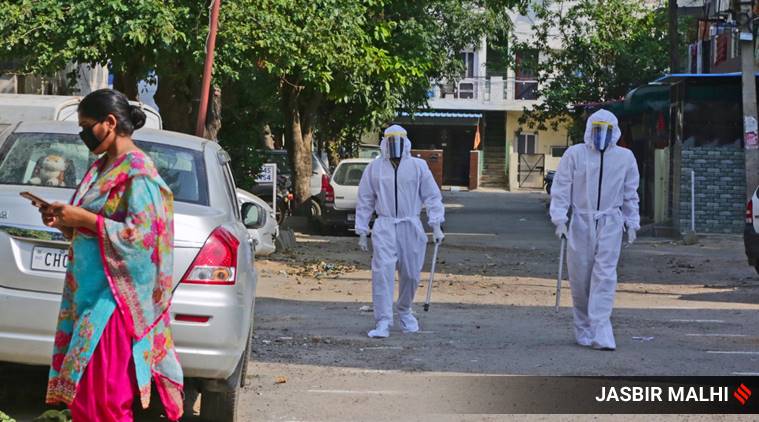- India
- International
What does Chandigarh’s high recovery rate imply?
Out of 454 reported cases of COVID-19 in Chandigarh, 393 have been deemed as recovered, while six people have succumbed to the disease, leaving only 55 active cases.
 With a recovery rate of 82.3 per cent, Chandigarh is placed first in the list of ‘top 15 states in terms of recovery rate’, released by the Ministry of Health and Family Welfare on Thursday. (Express file photo by Jasbir Malhi)
With a recovery rate of 82.3 per cent, Chandigarh is placed first in the list of ‘top 15 states in terms of recovery rate’, released by the Ministry of Health and Family Welfare on Thursday. (Express file photo by Jasbir Malhi)
With a recovery rate of 82.3 per cent, Chandigarh is placed first in the list of ‘top 15 states in terms of recovery rate’, released by the Ministry of Health and Family Welfare on Thursday. The UT is followed by the states of Meghalaya Rajasthan, Uttarakhand and Chhattisgarh.
Out of 454 reported cases of COVID-19 in Chandigarh, 393 have been deemed as recovered, while six people have succumbed to the disease, leaving only 55 active cases. The Indian Express spoke to epidemiologists and public health experts to analyse the implications of Chandigarh’s high recovery rate, and understand how this rate of recovery has been achieved.
Why does Chandigarh have the highest recovery rate in India?
The Director Health Services (DHS) for the UT, Dr G Dewan states that a combination of pro-active measures has led to the city achieving the highest recovery rate in the country. “We have dedicated COVID-19 services, hospitals and quarantine centers. This recovery rate can be attributed to early detection, flu clinics and hospitals for screening patients. We also had a good ambulance system for COVID and Non-COVID patients and we conducted extensive IEC activities which helped in spreading awareness on good hygiene practices,” says Dr Dewan. The DHS adds that using alternative medical practices, including homeopathy and Ayurveda, has also helped in improving the immunity of the citizens.
Dr Suneela Garg, Head of the Department of Community Medicine at Maulana Azad Medical College in Delhi, explains that the city’s high rate of recovery rate can be attributed to a multitude of factors and does not necessarily imply that the city has performed better than others in handling the pandemic. “Of course, a part of this can be attributed to the system in place and the prompt response of health services. PGIMER is excellent in this regard and should be commended for its handling of patients with severe symptoms, but there are many other existing conditions which can affect the recovery rate in a city,” says Garg.

Apart from a robust healthcare system, the epidemiologist explains that the demographic of a city, the burden of the disease and individual immunity are also major parameters that effect a city or state’s recovery rate. “An individual’s immune response matters. If the population is healthier, well-fed, and lacking in co-morbidities, then it is likely to be less affected by the disease and hence, will recover faster,” says Garg. Indeed, a majority of patients in the city, especially from the erstwhile hotspot of Bapu Dham colony were asymptomatic or had very mild symptoms, which meant that according to the latest discharge policy, they were deemed as recovered within ten days of being diagnosed with the disease. This was the vital reason behind the regular discharge of big groups of patients from Dhanwantri Ayurveda College or Sood Dharamshala, even while cases from Bapu Dham colony ratcheted up.
About the demographics of Chandigarh, Dr Garg said that having a relatively wealthier, socially affluent and well-educated population as compared to bigger cities and state capitals such as Delhi, Mumbai, Chennai and Jaipur, also helped significantly in managing the pandemic in the UT. “It does not have big a population living in slums and congested places, where health parameters are already too low and so are hygiene standards, so it does not have an extremely high burden of cases with severe symptoms. This also helps in containing the spread of the virus and allows people to recover faster even if they get infected,” says Dr Garg.
Will the city be able to sustain a high recovery rate?
The recovery rate should not be viewed in isolation to judge the city’s performance in handling the pandemic. Though Chandigarh has the highest recovery rate in the country, it has a very low testing rate as compared to other states and Union Territories. Besides, the UT has the ninth highest positivity rate in the country. Limited testing and a stagnant testing strategy, which focuses on testing symptomatic patients and high-risk contacts of already diagnosed patients, implies that there might be a lot of patients who remain undiagnosed and the level of prevalence of the disease in the city remains unknown. This, accompanied by the fact that the city has not received a high number of patients with severe symptoms means that the UT cannot remain complacent with achieving the highest recovery rate in the country.
“Low testing and a high positivity rate means that the city is testing populations where they already know it is most likely to find positive cases. Random testing needs to be conducted, especially in patients with co-morbidities, to actually be cognizant of the burden of the disease in the city,” says an epidemiologist who has participated in national ICMR studies on the pandemic and was nominated to a task force committee, and wishes to remain anonymous. “It will be a real test if the city records a surge of patients with severe symptoms. Whether the city will be able to manage such a surge, and whether its health infrastructure is equipped to do so, we will only know then,” says the epidemiologist.
Apr 24: Latest News
- 01
- 02
- 03
- 04
- 05







































